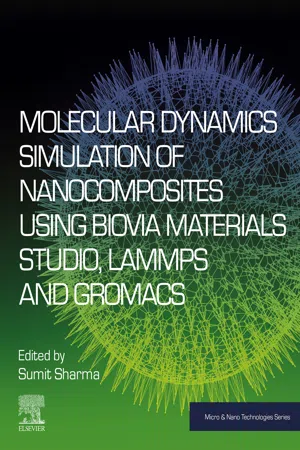
Molecular Dynamics Simulation of Nanocomposites using BIOVIA Materials Studio, Lammps and Gromacs
- 365 pages
- English
- ePUB (mobile friendly)
- Available on iOS & Android
Molecular Dynamics Simulation of Nanocomposites using BIOVIA Materials Studio, Lammps and Gromacs
About This Book
Molecular Dynamics Simulation of Nanocomposites using BIOVIA Materials Studio, Lammps and Gromacs presents the three major software packages used for the molecular dynamics simulation of nanocomposites. The book explains, in detail, how to use each of these packages, also providing real-world examples that show when each should be used. The latter two of these are open-source codes which can be used for modeling at no cost. Several case studies how each software package is used to predict various properties of nanocomposites, including metal-matrix, polymer-matrix and ceramic-matrix based nanocomposites. Properties explored include mechanical, thermal, optical and electrical properties.
This is the first book that explores methodologies for using Materials Studio, Lammps and Gromacs in the same place. It will be beneficial for students, researchers and scientists working in the field of molecular dynamics simulation.
- Gives a detailed explanation of basic commands and modules of Materials Studio, Lammps and Gromacs
- Shows how Materials Studio, Lammps and Gromacs predict mechanical, thermal, electrical and optical properties of nanocomposites
- Uses case studies to show which software should be used to solve a variety of nanoscale modeling problems
Frequently asked questions
Information
Introduction to Molecular Dynamics
Abstract
Keywords
- (i) BD methods, which can simulate the Brownian motion of dispersed particles
- (ii) DPD and lattice Boltzmann methods in which a liquid system is regarded as composed of virtual fluid particles
1.1 Molecular Dynamics
Table of contents
- Cover image
- Title page
- Table of Contents
- Copyright
- Dedication
- Contributors
- Preface
- Chapter 1: Introduction to Molecular Dynamics
- Chapter 2: Overview of BIOVIA Materials Studio, LAMMPS, and GROMACS
- Chapter 3: Molecular Dynamics Simulation of Metal Matrix Composites Using BIOVIA Materials Studio, LAMMPS, and GROMACS
- Chapter 4: Molecular Dynamics Simulation of Polymer-Matrix Composites Using BIOVIA Materials Studio, LAMMPS, and GROMACS
- Chapter 5: Molecular Dynamics Simulation of Ceramic Matrix Composites Using BIOVIA Materials Studio, LAMMPS, and GROMACS
- Chapter 6: Scripting in Molecular Dynamics
- Chapter 7: Applications of BIOVIA Materials Studio, LAMMPS, and GROMACS in Various Fields of Science and Engineering
- Index